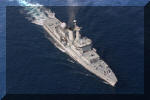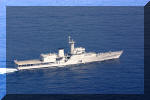Sukanya Class
- Details
- Category: Ships
- Published: Thursday, 31 August 1989 00:00
- Written by Large Patrol Craft
- Hits: 18629
Vessel Type: Large Patrol Craft.
Names & Pennant Numbers with commission dates:
INS Sukanya P50; Commissioned - 31 August 1989
INS Subhadra P51; Commissioned - 25 January 1990 - retrofitted with Dhanush stabilizer
INS Suvarna P52; Commissioned - 04 April 1991 - retrofitted with Dhanush stabilizer
INS Savitiri P53; Laid Down - 25 June 1988, Launched - 23 May 1989, Commissioned - 27 November 1990
INS Sarayu P54; Laid Down - 25 June 1988, Launched - 16 October 1989, Commissioned - 10 April 1991, Sold to Sri Lanka in 2000
INS Sharada P55; Laid Down - 16 June 1989, Launched - 22 August 1990, Commissioned - 16 December 1992
INS Sujata P56; Laid Down - 16 June 1989, Launched - 23 October 1991, Commissioned - 03 November 1993
Structure: Lightly armed and able to stage helos, they are fitted out for offshore patrol work but have the capacity to be much more heavily armed. Fin stabilizers are fitted and a fire fighting pump is present on the aft hanger roof.
Displacement: 1890 tons full load.
Main Machinery: Two diesel motors with 12,880 hp and 2 shafts.
Maximum Speed: 21 knots.
Maximum Range: 5800 miles at 15 knots.
Complement: 140 (incl. 15 officers).
Radar: Surface; One Racal Decca 2459 radar at I-band frequency.
.........Navigation; One Bharat 1245 radar at I-band frequency.
Helicopters: One HAL Chetak.
Weapons: One Bofors 40mm/60 gun at 120 rds/min to 5.5n miles; 10 km. May be replaced with a 76mm gun in due course. Has four 12.7mm machine guns.
Comments: First three vessels ordered in March 1987 from Korea Tacoma to an Ulsan Class design. Second four ordered in August 1987. The Korean-built ships were commissioned at Masan and then later sailed to India where the armament was fitted. Three ships, of a modified design called the Samar Class, have been built for the Coast Guard. These vessels are used for defense protection of offshore installations and patrol of the EEZ (Exclusive Economic Zone). Immarsat can be fitted on the hangar roof. Potential for role change is considerable. First three vessels based at Mumbai, the next pair at Vizag and the last pair at Kochi.
INS Suvarna and INS Ranjit, a Kashin-II Class missile destroyer, proceeded to Mozambique on a diplomatic mission. On 25 June 2003, this pair of ships attended the 28th Independence anniversary celebrations of Mozambique and presented medicines to the Vice Minister of Health of Mozambique on board INS Suvarna. At the request of President Joaquim Chissano of Mozambique, who boarded these ships on 30 June 2003, the Indian Navy ships remained in the area to provide cover for the African Heads of States Union, which was held from July 4th to 12th. They also trained the Mozambique Navy and weaved bonds of friendship during their stay. The US Navy, with USS Curtis Wilbur and P-3C Orions anti-submarine warfare aircraft, began a Search and Rescue exercise off Chennai with INS Sukanya and an Indian Coast Guard vessel on 06 July 2003. In the same area, in the Bay of Bengal, four units of the Western Fleet from Mumbai were all set to conduct summer exercises with the combined Fleets and the other services.
INS Sharada returned to Naval Base, Kochi after completing a 3½ month-long deployment (Operation Sagittarius) covering 20,000 nautical miles in August 2002. She is the first Indian Navy vessel to carrying out such escort operations since the 1971 Indo-Pak War. She is also the first Indian Naval ship to participate in this operation off the coast of Malaysia and was involved in escorting high value vessels of the United States Navy, which included a nuclear-powered submarine and naval auxiliaries. The theatre of operations included the Andaman Sea, the Malacca Straits and the South China Sea. During her deployment, which began in April 2002, INS Sharada undertook 12 escort missions. While operating in international waters, she came across many warships of regional and foreign navies including aircraft carriers USS Kitty Hawk and FNS Charles De Gaulle and the amphibious assault ship USS Essex. The ship embarked an armed HAL Chetak helicopter to facilitate effective aerial surveillance around the high value vessels.
INS Sukanya was employed as the Presidential Yacht for the International Fleet Review by President K. Narayanan, on 17 February 2001. She reverted to her normal role on completion. INS Subhadra and INS Suvarna have been modified to carry the Dhanush stabilizer for the Prithvi missile. The helicopter deck of these vessels have been converted into a missile launch pad, which has been strengthened and a hydraulically-stabilised, rail-mounted platform installed along with a missile erector. Two missiles are housed in the helicopter hangar and wheeled out for launch, one after the other. A portable console fitted on board feeds the missile guidance parameters before launch. INS Sarayu was sold to the Sri Lankan Navy in 2000, to effectively patrol its coast and mainly to deter the Liberation Tigers of Tamil Eelam (LTTE) from bringing in arms & ammunition. The vessel, renamed as SLNS Sayura, was refitted with new armament before being delivered.







